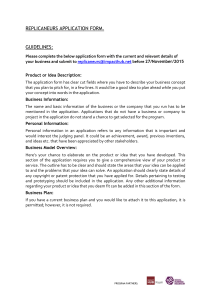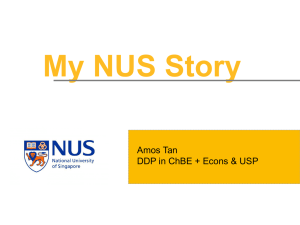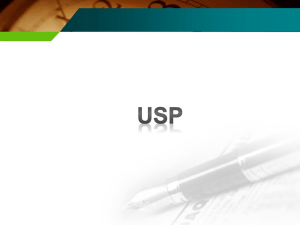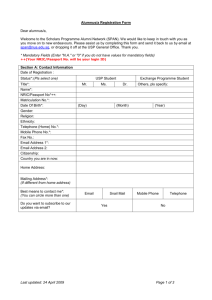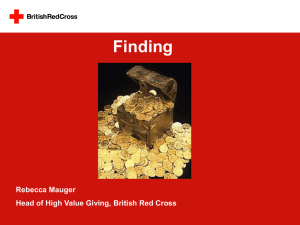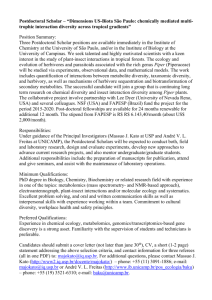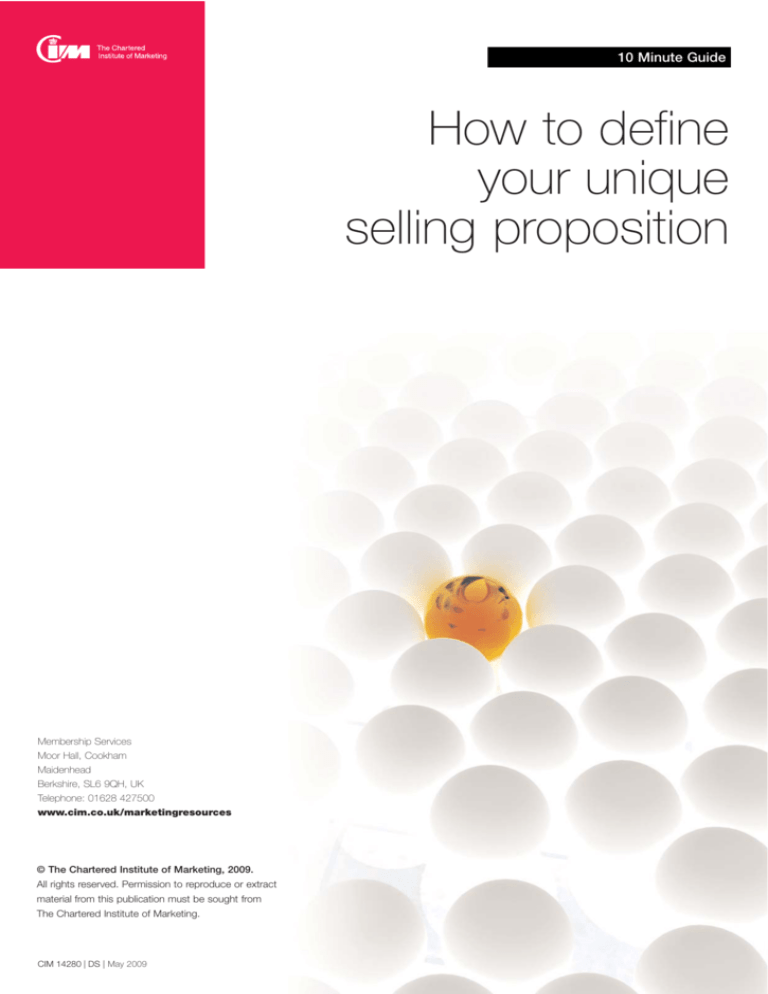
10 Minute Guide
How to define
your unique
selling proposition
Membership Services
Moor Hall, Cookham
Maidenhead
Berkshire, SL6 9QH, UK
Telephone: 01628 427500
www.cim.co.uk/marketingresources
© The Chartered Institute of Marketing, 2009.
All rights reserved. Permission to reproduce or extract
material from this publication must be sought from
The Chartered Institute of Marketing.
CIM 14280 | DS | May 2009
10 Minute Guide
How to
define your unique
selling proposition
Introduction
This item explains how to develop a unique
selling proposition for your business or a
product or service. It explains what a
unique selling proposition is and how you
use it. It then takes you through a process
to identify the features of your product or
service, to convert the features into benefits
that the customer will recognise and finally
to identify which benefits you are going to
use to develop your USP. It uses the
example of an optician to show how the
process can be used.
What it is
‘USP’ means unique selling proposition. It is
one of the basics of effective marketing and
business that has stood the test of time.
A USP can help customers by saving them
time when they are considering buying a
product or service. By stating simply and
clearly why your product or service is
different, it will stand out from the
competition. You can use a different USP
for every product or service within your
range. Alternatively, you may decide to use
a company-related USP, such as high levels
of customer service.
the effectiveness of, your promotion and
sales activities.
If you want to see examples of USPs in
practice, then advertising is a good place to
look. Advertising agencies have limited
space to convey all the features and
benefits of a particular product or service.
So, in just a few words, they seek to
communicate how the company is different
and what customers can expect when they
buy the product or service. A couple of
examples from a recent daily newspaper
include:
• Citroen want to draw attention to the
fact that not only do their cars have
new gizmos and gadgets (as do the
other manufacturers’ cars) but that
theirs have been designed with the
customer in mind (unlike other
manufacturers’): “Technology as it
should be: 100% useful”.
• Olympus cameras want potential
purchasers to know that a new model
can do all the things that a professional
would want but without requiring the
expertise, expense and effort required
to set up and produce quality results:
“All the features of a professional
camera without the fuss”.
Why it is important
Every business needs a USP for its
products and services. To stand out in
today’s crowded market place you must be
either BETTER or CHEAPER than your
competitors.
The process of identifying a USP helps you
to focus on the key benefits that help to sell
your products or services and contribute to
your profits. You can also use your USP to
provide a focus for, and therefore improve
CIM 14280 | DS | May 2009 | 2
10 Minute Guide: How to define your unique selling proposition
A thought: if you find that your customers
are switching to competitors or buying
purely on price:
• have you identified the USPs for your
products and services?
• if so, are you communicating your
USPs clearly to customers?
What you need to know
One of the advantages of USPs is that it is
a very easy concept to understand. You just
need to concentrate on making it work for
your business.
Before you start to use it, it helps to know:
• The features of the product or service
you wish to promote
• How and why the customer uses the
product or service
• Features of your competitors’ product
or service
You may already have this information from
your own experience, from your sales team
or from past market research. If not, call a
few customers and get their help – most
customers are happy to tell you why they
bought your product. Make sure that they
are representative of all your target
customers and encourage them to give you
an unbiased view.
When finances allow, this information
should be verified through market research,
whether you carry this out yourself or use
outside help.
Feature
What you should do
Here are some steps to work through to
define a USP for one of your products or
services.
1. Start with the product or service that
you most want to succeed, has the
greatest potential or provides the
largest contribution to your profits. If
you want to identify your most profitable
product or service, take a look at the
‘10- minute 18-20 Rule’.
2. List all the main features of the product
or service. Features describe what your
product or service does. Your list
should include features such as quality,
service, delivery, price, and functional or
technical characteristics.
3. Convert each feature into one or more
benefits. While features describe what
your product or service does, a benefit
describes what customer need it fulfils.
Converting features into benefits is very
important because customers buy
benefits, not features.
A simple technique which makes the task
of converting features into benefits much
easier, is to use the words “which means
that…” after stating the feature. Therefore,
what the feature “means” to the customer
is the benefit that they derive from it. If, at
the first attempt, the result of “which means
that…” is not a specific customer benefit,
simply use the words again until it becomes
one. Here are some examples for an
industrial machine:
…which means that…
Benefit
Reliability
The machine is available
more hours of the working day
Operating speed
The machine produces 10%
more widgets than
comparable machines
Ease of use
The machines requires
minimal training for operators
CIM 14280 | DS | May 2009 | 3
10 Minute Guide: How to define your unique selling proposition
4. Some benefits will be more important to
the customer than others. Look down
your list of benefits and rank them in
priority order.
5. Consider each benefit in turn and
indicate whether this benefit is:
• standard to all competing suppliers’
products or services (S)
• something that is different and
special to you (D) – these are
candidate unique selling
propositions.
6. If all your benefits are rated 'S', then
this indicates that there are no obvious
differences between your products or
services and those of your competitors.
In this case there are two things you
can do:
• Consider how your company scores
against your competitors on those
benefits that the customer
considers to be most important.
Look for those benefits where your
rating is high and shows the biggest
difference between you and the
competition. This analysis will reveal
whether you have particular
strength that may be exploited in a
similar way to a USP.
• Consider how you could develop
your product or service features to
deliver new customer benefits that
are not provided by other suppliers.
What to do now
When you have defined a USP for each of
the products or services you are
considering, then you should decide what
your message should be and how to
communicate it to your target audience. For
more information on planning your
marketing communications, take a look at
the 10-minute Promotional Mix).
Where to find out more
A good way to learn about identifying and
using your USPs is to watch marketing
communications from other companies, for
example their advertisements, mail shots
and press articles. See if you can spot what
the company see as their USP and the
message they are using to communicate
with their target audience.
An example in practice
Let us look at the example of a local
optician.
The table shows how the optician has
identified the features of the service (step
2), converted the features into benefits that
customers will value (step 3), ranked the
benefits in order of importance (step 4) and
identified the benefits as being ‘standard’ or
‘different’ (step 5).
7. Repeat this process for all other major
products or services.
8. When you have done this, think about
your promotional activities.
CIM 14280 | DS | May 2009 | 4
10 Minute Guide: How to define your unique selling proposition
Features
Customer Benefit
(“which means that…”)
Importance
(/10)
Standard or
Different
40 minute eye tests
Customers can expect a
detailed eye examination
9
S
Competitive prices
Customers will not pay
more than at comparable
local practices
9
S
Qualified dispensers
Customers get professional
advice on lens options and
frame styles
8
S
Wide range
of frames
It is likely that a frame will
be available in the style
that you want
8
S
Friendly and
personal service
The practice cares about
its customers
7
S
Instant photo
machine
Customers can see what
they look like in different
frame styles
7
D
Automatic
reminders for
next eye test
Customers don’t have to
remember when they are
next due for an eye test
5
S
... which means that …
Customers know that the health
of their eyes will be monitored
for them at suitable intervals
Note the last feature relating to eye test
reminders did not yield a clear customer
benefit at the first attempt, so the
techniques were reapplied. On the second
attempt a clear customer benefit does
result.
You can see in this example that only one
feature is unique to this optician, the special
photo-equipment which allows the
customer to see how they look in a small
selection of frames and in doing so helps
them to make the final choice. This is
helpful because display frames have clear
lenses, which means that customers with a
sight correction and wearing the new
frames cannot see themselves clearly in the
mirror. These special photographs enable
the customer to wear their own spectacles
and see clearly how they look from different
angles.
This equipment, and the customer benefit it
delivers, therefore provides a USP for the
optician. This USP can be highlighted in
promotional activity, and hopefully, as this
benefit is important to the customer (7/10),
attract new business.
CIM 14280 | DS | May 2009 | 5
10 Minute Guide: How to define your unique selling proposition
However, no USP will last forever.
Competing opticians may notice that this
service is being provided and may
experience the loss of customers. In this
case, after some time (perhaps two years)
all competing practices will provide this
service and the service will become a
standard offering. The optician therefore
needs to go through this process once in a
while, particularly after a competitor has
launched a new service to catch up or try
to get ahead.
Finding out more
Visit
www.cim.co.uk/marketingresources
gives more useful advice for small
businesses wanting to build on their
marketing knowledge.
CIM 14280 | DS | May 2009 | 6


